After spending the last several hours gazing in awe and wonder at the genius of Antonin Gaudi and his Sagrada Familia, we needed an absolute change of scenery. Montjuic or Hill of the Jews was a large complex that comprised the Catalan Art Museum, the Castle of Montjuic, the Joan Miro Museum, Caixa Forum, Magic Fountains, and oh yes, it was the site of the 1929 World Exposition and the site for the 1992 Olympics, too! All that sounded pretty overwhelming considering we were starting well after noon so we took it just one step at a time by taking the metro and then the bus to the Castle. It was built in the 18th century by the central Spanish government to keep an eye on Barcelona and stifle citizen revolt. Being 'taken to Montjuic' meant prisoners would likely never return again.
I learned about a very disturbing chapter in Spanish history when Lluis Companys, President of the Autonomous Catalan Government known as the Generalitat, went into exile during the Spanish Civil War in France when General Franco's army was about to occupy Barcelona in January of 1939. After being handed over to the new Spanish authorities by the Gestapo and the French Vichy government on October 3, 1940, Companys was incarcerated in secret in the Castle chaplain's quarters. The president who had raised the Catalunya flag over the castle was imprisoned in the castle.
He was sentenced to death immediately and executed the following day. Lluis Companys is the only democratically-elected incumbent president in Europe to have been executed. Although later both the French and German governments expressed their apologies for their roles in the arrest and deportation of the President, the Spanish government still has never declared that trial null and void.
The model of Montjuic showed the lighthouse, fort and fortress.
The repression of Barcelona from Montjuic Castle began after the War of the Spanish Succession from 1793-95 when the defense of the Bourbon authority prioritized military control and subjugation of the population. From the 19th century onwards with the industrialization of Catalunya, Republican ideals and the workers' movements opposed the persistence of an absolutist and militarized state. Repression was indiscriminate and freedoms were violated from the castle.
Joseph Kessel, a journalist and writer wrote that Montjuic was both a citadel and a prison, and that it is to Barcelona what the Bastille is to Paris. It was where generations of captives awaited their sentence in it. A black flag arose from atop the tower of Montjuic each time there had been an execution.
In a gripping exhibition called Lost Memory, I learned that the bodies of up to 114,000 'disappeared' individuals from the Spanish Civil War and Franco's dictatorship lie in unmarked graves on roadsides, on the edges of towns and villages. More than 200,000 civilians were murdered during the Civil War on both sides, most of them far removed from the battlefield, in areas without resistance. 150,000 were put to death in the Franco-controlled zone. 20,000 more were shot in the weeks following Franco's victory.
Photographer Miquel Gonzalez researched the scenes of violence where atrocities had been committed that hadn't yet been excavated or commemorated. Many sites were lost, hidden under new roads or buildings, or have just disappeared without any trace or sign marking their cruel past. Gonzalez wanted the invisible past to become of equal importance to the visible present in his photographs.
Gonzalez captured each location as close as possible to the hour, day and season of the year that the atrocity took place. Most of the photographs were taken after sunset and before sunrise, the preferred hours for 'taking a stroll' and executions. As the curator wrote, the emptiness and silence of these hours gave the landscapes a certain serenity that belied the horrors which took place there.
According to oral histories, more than 6,500 people were murdered along the road between Vizmar and Granada. Between 2,500 and 3,000 people are believed to have been buried in this ravine between 1936 and 1951.
Miro explained the land and mountains around his birthplace had a very important role in his life and was the force that nurtured him. It was at his favorite village of Mont-roig that he set out to rethink his entire conception of painting and succeeded in striking a balance between tradition and modernity. Decades later, he began working in ceramics and sculpture at Mont-roig.
I guess only an artist of Miro's standing in the art world could get away with this 'work' called simply Painting! He wrote that "Silence is a denial of noise - but the smallest noise in the midst of silence becomes enormous. As the only referential element, a blurry point acquires a powerful presence, but also makes the space around it resonate."
These are exampled of Miro's Anti-Painting phase where he liked to torture the canvas with unconventional practices - wounding, perforating and burning it. By challenging the very notion of painting, he questioned the economic value and interests of the art market, using the practice of art to join the growing struggle for freedom that emerged toward the end of the Franco dictatorship.
It seems I was too hasty calling these works sculptures as apparently "The rustic textures, real objects and non-pictorial materials such as tar spread onto a base of jute and hemp, abrasions and footprints do not fit into any artistic category; they are neither paintings nor sculptures nor textile works. Their radicalism lies in negation rather than affirmation."
Alexander Calder designed the Mercury Fountain for the Spanish pavilion at the World's Fair in 1937 in Paris. With the sculpture, Calder paid tribute to the Spanish town of Almaden where 60% of the world's mercury was then mined and and which was being besieged by Franco's troops during the Spanish Civil War.
Shortly after Miro's death in 1983, the Fondacion's Board of Trustees asked renowned 20th century artists or their family members, friends and collaborators to donate a piece in the artist's memory. Three years later the resulting collection of works, called Homage to Joan Miro, were presented to the public. The following artists donated works. I had never heard of any other museum doing anything like this and thought it was a brilliant concept.
Romanesque art developed in Europe between 1000 and the beginning of the Gothic period, from 1150 or later depending on the region. The term was adopted in the 19th century to designate the stage of medieval art in which architecture used styles similar to the great ancient Roman architecture.
The Boi Valley is one of the regions in the Catalan Pyrenees - as opposed to the more well-known French Pyrenees - where the most Romanesque art has been conserved, because of its importance during the Middle Ages but also to its subsequent isolation that prevented it from disappearing. The use of colors and well-defined shapes in the church from Iglesia de Sant Joan frescoes were similar to the procedures used in the illustrations of manuscripts from the same era.
We watched a fascinating video that showed how some of the paintings were detached from the walls of the Church of Sant Joan in Boi in 1978 using the strappo technique. It involves gluing a canvas to the surface of a fresco and easing away a thin layer of plaster containing the pigment particles of the fresco.
If you look closely by clicking on the photo to make it bigger, you'll see some pretty gruesome images in this panel painting!
How striking and still so timeless in their beauty were these pieces that were 800 plus years old!
In the Gothic wing, there were vivid 14th century wood-panel paintings of Bible stories.
There were also minor works by major - if not necessarily Catalan artists - such as Rubens (below), Velasquez, El Greco, Goya, Tintoretto and others.
We still weren't quite 'done' with the museum as there was a gallery called Popular Narratives that seemed appealing. Rather than dealing with paintings of royals and religious topics, artists became curious about the humbler strata of society. While some of the images had an implicitly moralizing purpose, most were light-hearted exercises intended to engender feelings of sympathy from the vantage point of moral superiority.
The castle, built to protect the city, became its repressor and a place of imprisonment during the Spanish Civil War from 1936-1939. After the death of Franco in 1975, Barcelona began to debate the region's historical memory and the dark story of the castle came to an end. Now the castle serves as a park, jogging destination and host to a popular open-air cinema.
The drawbridge and facade were part of the defensive improvements made in 1751.
The royal coat of arms of Charles III of Bourbon was originally on the facade.
After going through a small tunnel, we saw the Guardhouse; on either side were two large storage areas.
From the ramparts on the upper part of the castle we had a glorious view of Barcelona's harbor and the cruise ships who regularly come to the city.
The castle's four Bastions, including Bastion Sant Carles, were defensive structures that protruded from the walls of the fortress to force the enemy to retreat and move further away from the fortress.
Around the Parade Ground, the most heavily protected area in the castle, was a series of rooms or bunkers lined and covered with bombproof vaults that housed the officers' quarters, the residence of the governor and the canteen.
I learned about a very disturbing chapter in Spanish history when Lluis Companys, President of the Autonomous Catalan Government known as the Generalitat, went into exile during the Spanish Civil War in France when General Franco's army was about to occupy Barcelona in January of 1939. After being handed over to the new Spanish authorities by the Gestapo and the French Vichy government on October 3, 1940, Companys was incarcerated in secret in the Castle chaplain's quarters. The president who had raised the Catalunya flag over the castle was imprisoned in the castle.
Eleven days later, Companys was taken across the parade ground to be court-martialed, in what would be a summary trial without any procedural guarantees and which didn't even comply with the new regime's own laws. He was accused of treason for using his position as President of the Generalitat to implement left-wing policies, oppose Franco's military coup and support the Resistance.
He was sentenced to death immediately and executed the following day. Lluis Companys is the only democratically-elected incumbent president in Europe to have been executed. Although later both the French and German governments expressed their apologies for their roles in the arrest and deportation of the President, the Spanish government still has never declared that trial null and void.
The rooms were mostly empty except for this display of a Star of David, possibly to illustrate the hill's Jewish roots. It wasn't however until we saw its reflection that we noticed it was a Jewish star. How very, very clever.
The tombstone was from from the Jewish cemetery at Montjuic and was dated 1306.
The model of Montjuic showed the lighthouse, fort and fortress.
The photo showed the inauguration of Companys' tomb and of the memorial to the victims of Franco's dictatorship in November of 1985.
During Franco's dictatorship from 1939-1975, the castle operated as a military prison and barracks until 1960. Franco then had it restored and transferred to the city but under military control. in 1963, Franco opened the Military Museum of Montjuic. The castle returned to the city in 2007, thirty years after the end of the dictatorship and the restoration of independence. Two years later, the museum was dismantled.
Joseph Kessel, a journalist and writer wrote that Montjuic was both a citadel and a prison, and that it is to Barcelona what the Bastille is to Paris. It was where generations of captives awaited their sentence in it. A black flag arose from atop the tower of Montjuic each time there had been an execution.
I read that because it was unusual to build towers in the defensive architecture of the Modern Age, Montjuic Castle was interesting because of the presence of this Watchtower. It was reminiscent of the first defensive construction at the top of the mountain, which was documented as early as 1073.
A view into the parade ground:
According to oral histories, more than 6,500 people were murdered along the road between Vizmar and Granada. Between 2,500 and 3,000 people are believed to have been buried in this ravine between 1936 and 1951.
From April, 1939 to March of 1940, hundreds of prisoners were executed at the Badajoz Concentration Camp or 'taken for a stroll.' Among the early victims was mayor Jose Gonzalez Barrero who disappeared between April 26 and 29th of 1939. The mine of La Gamonita shown here and other mines around the concentration camp are believed to contain hundreds of the disappeared.
This field now had to reserved for grazing because plowing in the past turned up human remains.
After that sorrowful visit we walked to the Fondacio Joan Miro to see the best collection anywhere of works by Catalan artist Joan Miro. Born in Barcelona, the artist divided his time between Paris and Catalunya. This building was built by a friend of Miro's and a student of Le Corbusier to show off Miro's art.
Miro explained the land and mountains around his birthplace had a very important role in his life and was the force that nurtured him. It was at his favorite village of Mont-roig that he set out to rethink his entire conception of painting and succeeded in striking a balance between tradition and modernity. Decades later, he began working in ceramics and sculpture at Mont-roig.
I read that "In an artistic environment dominated by Noucentisme, Miro's earliest paintings revealed an eclectic style that combined Cubist facets with Fauvist colors and the solidity of Cezanne with the lines of force used by the Futurists." Not being up in all the art movements, I'm not quite sure what that meant but perhaps some readers will! Miro acquired his knowledge of art through exiled artists living in Barcelona, exhibitions and avante-garde Catalan and French magazines.
I began to wonder what we'd gotten ourselves up to coming to see this museum when I saw this work called Painting on white background for the cell of a recluse.
Steven wanted me to take this picture of him as a screensaver for our computer. When we're home in Denver, he normally changes the screensaver every night for me so it's a surprise when I come down in the mornings and look at the picture he's chosen from one of our trips. I wonder when I'll see this one on the desktop!
The sign beside this said that Miro's sculpture is based on an assemblage of objects. The object upends the problem of representation; art is no longer what interprets reality but rather everyday items are the ones that adopt a new identity in the aesthetic context.
After being exposed to Miro's later more unconventional art, I appreciated escaping outside and exploring some of his sculptures.
Rarely have we been in museums that have asked visitors for feedback and to express their opinions as to what they've seen as the Fondacion Joan Miro did. I appreciated it and also wondered what was done with the comments that were left.
Some more works - sculpture or not - that are bound to make you smile!
The collection of donated works was always rotating so there was only a limited number in the gallery.
Matisse's Head of a Woman was one of the works donated.
After being intrigued and educated somewhat if not captivated by Miro's art, we walked through some beautiful gardens toward the Catalan Art Museum which was also part of Montjuic.
The vision for the wonderful Museu Nacional d'Art de Catalunya or MNAC for short was to showcase Catalan art from the 10th to the middle of the 20th century. The museum was housed in the grand Palau Nacional from the 1929 World Expo. The view from the terrace over the city was probably the prettiest from any museum anywhere.
It was hard not to be wowed in the first hall of the Romanesque Gallery and seeing the most gorgeous frescoes I can ever imagine seeing anywhere. I learned that MNAC's rare, world-class collection of Romanesque art came mostly from remote Catalan village churches in the Pyrenees that were moved to the museum in the early 1920s to save them from scavenging art dealers.
Lina: If you and Dan ever do get a chance to visit Barcelona, I hope you will make time to spend a chuck of time at MNAC if only to see the most outstanding collection of frescoes. They are arranged as if you were transported to the churches the frescoes were detached from - just beyond spectacular!
The MNAC's collection of Romanesque panel paintings is one of the most important in the world.The most significant works were the altar frontals. Painted works offered an affordable alternative to furniture in precious metal which only a few rich churches could afford. They were also a high-quality product and a highly prized resource for the liturgical decoration of churches.
Even after watching the video, it was still amazing to think this fresco had been 'detached' from a church wall as it looked so perfect and as if it had always been there like that. The colors were still so very rich.
There was a significant collection of monumental sculpture by Romanesque sculptors that was similar to that of late antiquity in the Mediterranean region.
One of the most unusual experiences I've ever had in a museum was having to wear 3D glasses to watch a virtual reproduction of the portal of the abbey church of Santa Maria in Ripoll, one of the most important works of sculpture in Catalan Romanesque art. With the 3D glasses, we were able to navigate the sculptures and observe them from lots of points of view! A little gimmicky, but neat!
The production of religious images in wood was another important facet of Catalan Romanesque art. It was surprising that so many carvings from the 12th and 13th centuries have been conserved. Many of the sculptures still had remains of polychromy which was always applied to the carved images and to sculptures in stone to give them a more naturalistic look and to emphasize the expressive features or the ornamentation. Apart from their devotional function in churches, they also played an active part in the liturgy of church.
In the Gothic wing, there were vivid 14th century wood-panel paintings of Bible stories.
The museum had an extensive collection of Renaissance works covering Spain's Golden Age with heavy religious scenes and Spanish royals with their famous underbites!
And, of course, being Spain there was a collection of very religious paintings called Passion and Sacrifice.
The position of the sculpted figures was about how I felt at that point in the day after seeing so much art beginning with the sublime La Sagrada Familia, the heart wrenching historical displays at Montjuic Castle, Joan Miro's works and then the overwhelming amount of art through the ages at MNAC.
The space under the museum's huge dome had once housed an ice-skating rink and the prime ceremony room and dance hall for the 1929 World Expo. The Oval Room could hold 1,400 people and the stands on the side could seat 500. The arches of the grandstand on the first floor were decorated with the 50 coats of arms, each representing the different Spanish provinces.
We had just begun walking through the Modern Art section when we were shooed out of the museum at 6. Some people close down bars; it seems fairly regularly we close down museums!
I was glad I spotted this painting on the way out by Ramon Casas as he had a profound effect on a young Pablo Picasso and, through him, on all modern art. Casas was also one of the financiers of Els Quatre Gats, a popular hangout for Modernista artists. Stay tuned for a photo of the bar/restaurant!
Looking out onto the grand terrace and, thus, over the city:
Outside looking back up at MNAC, one of the finest museums in my mind in Barcelona.
The water feature was top-notch, just like everything else at the museum, as it cascaded down level over level.
This American couple was renewing their wedding views on the beautiful grounds at MNAC. What a romantic place to be doing that.
The water feature continued down about ten flights of stairs.
Near MNAC were more of the 1929 World Expo fairgrounds but we didn't have the energy to see any more that day!
One long day of sightseeing had begun when it was still dark at 8 and got back to our apartment close to 8 when it was again dark!
Next post: Barcelona's Picasso Museum & Gothic Quarter Take 2
Posted on November 27th, 2018, from Algeciras in southern Spain.
Next post: Barcelona's Picasso Museum & Gothic Quarter Take 2
Posted on November 27th, 2018, from Algeciras in southern Spain.









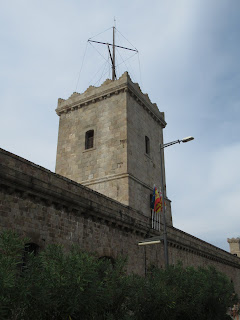

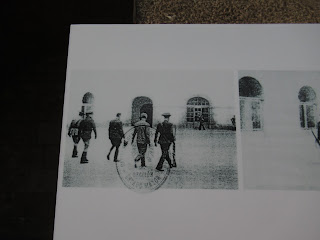





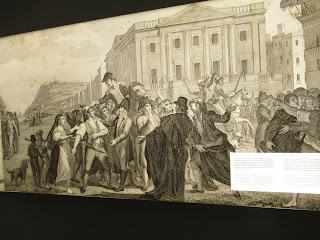
























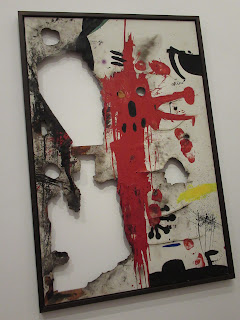






















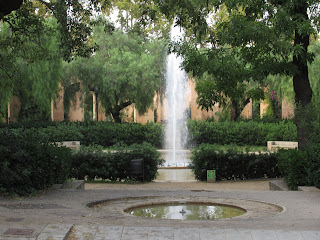















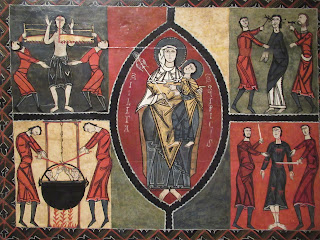











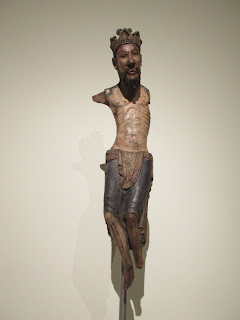











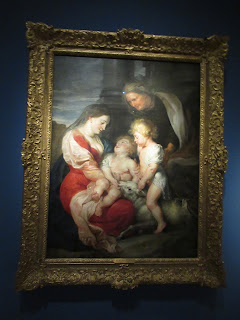










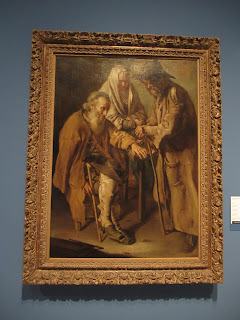















Well you've certainly got a bumper crop of screen savers there. You're lucky to have that put up for you too. :)
ReplyDeleteBeautiful work, Annie! Fun to see the castle and I enjoyed the Miro, especially the more "straight" abstracts. Playful!
Andrew, You're right, I am SO lucky Steven posts new screensavers of travel pics for me most days when we're home! I think I speak for both Steven and myself that we felt 'educated' by the Miro museum but thoroughly enchanted and enthralled by the Romanesque frescoes at the National Museum of Catalan Art. As they say, each to their own, eh!
ReplyDelete